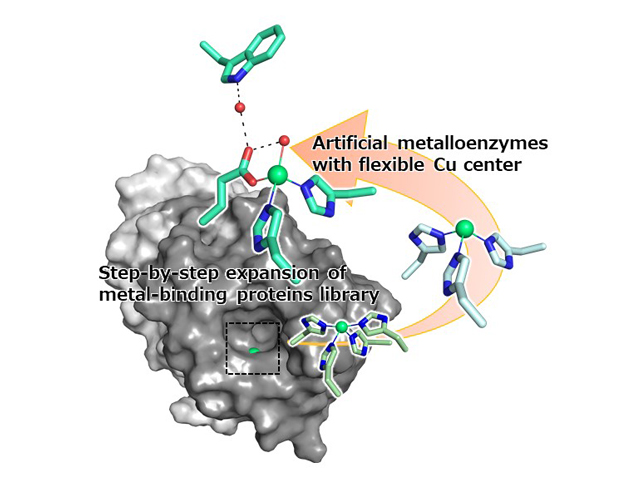Research News
Mar 29, 2023
Success in simple creation of artificial metalloenzymes with high stereoselectivity
Opens mechanistic study of natural enzymes
Exosomes from cancer-associated fibroblasts may suppress malignant melanoma
The flexible copper (Cu) center, created using a modified 2-his-1-carboxylate metal-binding motif, gives the artificial metalloenzyme improved stereoselectivity as the copper, possibly by allowing the copper ion to move into the position where it is most likely to bind.

Enzymes work in the cells of all living organisms, allowing specific and complex reactions to be carried out quite easily. However, few natural enzymes are effective for industrial applications, which could benefit greatly from discoveries that make targeted enzyme creation a reality.
Artificial metalloenzymes can be created simply by binding metal ions or metallic compounds to proteins, so that they exhibit enzymatic activity. Currently, metalloenzymes are being studied to discover new functions or improve their reactivity when compared to natural enzymes. Nevertheless, the reaction mechanisms of metalloenzymes are still largely unknown, making it very difficult to design artificial enzymes for specific functions or improved efficiency.
A research group led by Professor Nobutaka Fujieda, Graduate School of Agriculture, Osaka Metropolitan University, has been creating artificial metalloenzymes using small heat-resistant metal-binding proteins. In their latest study, they describe an artificial metalloenzyme they created simply, making use of the 2-his-1-carboxylate metal-binding motif, which is commonly found naturally in non-heme metalloenzymes.
Their new artificial metalloenzyme has a metal-binding site composed of four amino acids, which originally were histidines. The research group mutated these amino acids to create a library of 12 slightly different proteins to compare. After screening the library, they found that the enzyme variant H52A/H58E, when bound with a copper ion, had the best stereoselectivity, so that it reacts selectively with the correct version of the target molecule.
The research group then performed X-ray crystallographic analysis of the metal-binding site, confirming two electron densities derived from the copper ions. Furthermore, docking simulations of two copper ions found that the copper, which protruded slightly, could bind to the substrate. Leading the group to believe that selectivity was maximized by the movement of the copper ion to where the substrate was most likely to bind.
"Such positional transitions of metal ions have also been observed in natural enzymes, so we believe that detailed analysis of our artificial metalloenzyme’s reaction mechanism will deepen what we know about natural enzymes. We hope that the advances of this research will lead to the creation of biocatalysts that can work under mild conditions," Professor Fujieda concluded.
The research results were published in Chemical Science on March 13, 2023.
Funding
JSPS, MEXT, Japan, (JSPS KAKENHI 18H04270 and 21H01954)
NOVARTIS Foundation (Japan) for the Promotion of Science
Sumitomo Foundation
Osaka University (proposal numbers 2021A6500, 2021B6500, 2022B6500, 2022B6500)
Paper Information
Journal: Chemical Science
Title: An artificial metallolyase with pliable 2-his-1-carboxylate facial triad for stereoselective Michael addition
DOI: 10.1039/D2SC06809E
Author: Ryusei Matsumoto, Saho Yoshioka, Miho Yuasa, Yoshitsugu Morita, Genji Kurisu, Nobutaka Fujieda
Publish: Mar 13, 2023
https://doi.org/10.1039/D2SC06809E
Contact
Graduate School of Agriculture
Nobutaka Fujieda
E-mail: fujieda[at]omu.ac.jp
*Please change [at] to @.
SDGs
